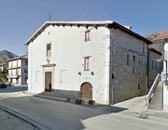


This church was built on the site of a Marian oratory that stood on land that belonged to the episcopal authorities of Gubbio. In 1601, Bishop Andrea Sorbolonghi agreed that all donations made to the existing oratory could be used to build this new church, which was to be administered by a new confraternity, the Confraternita del Suffragio.
Relations between Bishop Sorbolonghi and the Confraternita del Suffragio broke down in 1604 and Duke Francesco della Rovere attempted to mediate. However, matters were only resolved by the bishop’s death in 1616.
An attempt by Cardinal Giuseppe Pecci to establish Santa Maria del Suffragio as a parish church in 1850 failed because of the difficult political situation. It finally became a parish church in 1984.
Exterior
The arms over the portal in the plain facade are those of the Commune of Gubbio.
The inscription on the collection box to the left of the portal solicits alms for souls in Purgatory.
Interior
The interior is in the form of a single nave without a transept, and with three chapels on each side.
Wooden furniture (late 16th century)
These carved wooded fitments, which are attributed to Antono Maffei, comprise:
-
✴four altars (1581), which are dated by an inscription on one of them (the 2nd on the left); and
-
✴the balustrade on the counter-facade, which is dated from a fragmentary inscription to the 1590s (159...)
Since the fitments pre-date the construction of the church, they must have been moved here from another location.
Crucifixion (1599)
The recent restoration of this altarpiece on the 3rd altar on the right revealed the signature of Virgilio Nucci and the date. Since it pre-dates the construction of the church, it must have been moved here from another location. It depicts the moment when the dying Christ confers responsibility for His mother on St John the Evangelist and includes St Mary Magdalene kneeling at the foot of the cross. The dying Christ is surrounded by angels, and God the Father looks down from a small panel above.
Immaculate Virgin and saints (1645)
The Confraternita del Suffragio commissioned this banner from the aged Federico Brunori and Bishop Alessandro Sperelli blessed it before it was brought in procession to the church. It depicts the Immaculate Virgin in glory. SS Mark and John the Evangelist below flank a depiction of souls in Purgatory, in which SS Gabriel, Michael, and Raphael identify the saved. The banner is now used as the altarpiece of the second altar on the left.
Vision of St Antony of Padua (17th century)
This altarpiece on the 1st altar on the left is possibly the fruit of a collaboration between Giovanni Battista Michelini, il Folignate and Carlo Brozzi. It depicts St Antony meditating on an image of the Madonna and Child in glory, as the baby Jesus descends and approaches him.
St Catherine of Alexandria (17th century)
This altarpiece on the 2nd altar on the right is attributed to Giovanni Battista Michelini, il Folignate. It depicts the standing saint as an angel places a cron on her head. It was restored in 2008.
SS Antony Abbot and Francis (17th century)
This altarpiece on the 1st altar on the right is attributed to Carlo Brozzi.

